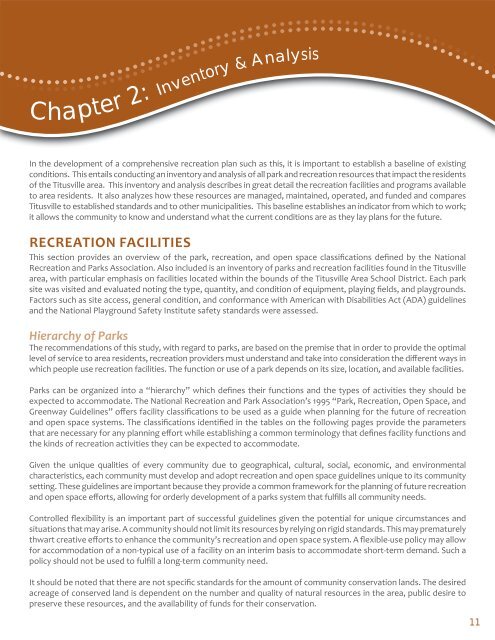2013 RECREATION, PARK, and OPEN SPACE ... - Titusville City Hall
2013 RECREATION, PARK, and OPEN SPACE ... - Titusville City Hall
2013 RECREATION, PARK, and OPEN SPACE ... - Titusville City Hall
You also want an ePaper? Increase the reach of your titles
YUMPU automatically turns print PDFs into web optimized ePapers that Google loves.
Chapter 2: Inventory & Analysis<br />
In the development of a comprehensive recreation plan such as this, it is important to establish a baseline of existing<br />
conditions. This entails conducting an inventory <strong>and</strong> analysis of all park <strong>and</strong> recreation resources that impact the residents<br />
of the <strong>Titusville</strong> area. This inventory <strong>and</strong> analysis describes in great detail the recreation facilities <strong>and</strong> programs available<br />
to area residents. It also analyzes how these resources are managed, maintained, operated, <strong>and</strong> funded <strong>and</strong> compares<br />
<strong>Titusville</strong> to established st<strong>and</strong>ards <strong>and</strong> to other municipalities. This baseline establishes an indicator from which to work;<br />
it allows the community to know <strong>and</strong> underst<strong>and</strong> what the current conditions are as they lay plans for the future.<br />
<strong>RECREATION</strong> FACILITIES<br />
This section provides an overview of the park, recreation, <strong>and</strong> open space classifications defined by the National<br />
Recreation <strong>and</strong> Parks Association. Also included is an inventory of parks <strong>and</strong> recreation facilities found in the <strong>Titusville</strong><br />
area, with particular emphasis on facilities located within the bounds of the <strong>Titusville</strong> Area School District. Each park<br />
site was visited <strong>and</strong> evaluated noting the type, quantity, <strong>and</strong> condition of equipment, playing fields, <strong>and</strong> playgrounds.<br />
Factors such as site access, general condition, <strong>and</strong> conformance with American with Disabilities Act (ADA) guidelines<br />
<strong>and</strong> the National Playground Safety Institute safety st<strong>and</strong>ards were assessed.<br />
Hierarchy of Parks<br />
The recommendations of this study, with regard to parks, are based on the premise that in order to provide the optimal<br />
level of service to area residents, recreation providers must underst<strong>and</strong> <strong>and</strong> take into consideration the different ways in<br />
which people use recreation facilities. The function or use of a park depends on its size, location, <strong>and</strong> available facilities.<br />
Parks can be organized into a “hierarchy” which defines their functions <strong>and</strong> the types of activities they should be<br />
expected to accommodate. The National Recreation <strong>and</strong> Park Association’s 1995 “Park, Recreation, Open Space, <strong>and</strong><br />
Greenway Guidelines” offers facility classifications to be used as a guide when planning for the future of recreation<br />
<strong>and</strong> open space systems. The classifications identified in the tables on the following pages provide the parameters<br />
that are necessary for any planning effort while establishing a common terminology that defines facility functions <strong>and</strong><br />
the kinds of recreation activities they can be expected to accommodate.<br />
Given the unique qualities of every community due to geographical, cultural, social, economic, <strong>and</strong> environmental<br />
characteristics, each community must develop <strong>and</strong> adopt recreation <strong>and</strong> open space guidelines unique to its community<br />
setting. These guidelines are important because they provide a common framework for the planning of future recreation<br />
<strong>and</strong> open space efforts, allowing for orderly development of a parks system that fulfills all community needs.<br />
Controlled flexibility is an important part of successful guidelines given the potential for unique circumstances <strong>and</strong><br />
situations that may arise. A community should not limit its resources by relying on rigid st<strong>and</strong>ards. This may prematurely<br />
thwart creative efforts to enhance the community’s recreation <strong>and</strong> open space system. A flexible-use policy may allow<br />
for accommodation of a non-typical use of a facility on an interim basis to accommodate short-term dem<strong>and</strong>. Such a<br />
policy should not be used to fulfill a long-term community need.<br />
It should be noted that there are not specific st<strong>and</strong>ards for the amount of community conservation l<strong>and</strong>s. The desired<br />
acreage of conserved l<strong>and</strong> is dependent on the number <strong>and</strong> quality of natural resources in the area, public desire to<br />
preserve these resources, <strong>and</strong> the availability of funds for their conservation.<br />
11


